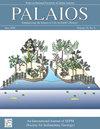乌拉圭rÍo de la plata, 20年后入侵腹足动物rapana venosa (valenciennes, 1846)死壳的发音特征
IF 1.5
4区 地球科学
Q2 GEOLOGY
引用次数: 2
摘要
摘要:毒腹蛛(Rapana venosa,Valenciennes,1846)是一种入侵性腹足纲动物,22年前它来到拉普拉塔河口已有文献记载。在两次采样过程中,从四个具有不同基质类型和波浪能状态的海滩上采集了细纹蛇壳,以比较不同环境条件下的直震特征。我们通过比较音调属性的频率来分析样本。我们的研究结果表明,具有岩石基质的中等反射海滩主要由中等至高度破碎的标本组成,具有高腐蚀性、中等至高生物侵蚀性、低生物结皮性和中等至大尺寸。相比之下,具有沙质基质、可移动石块和偶尔固结沉积物的中等耗散海滩主要由碎片较少的贝壳、高至中等侵蚀、生物侵蚀较少、生物结壳较低和中小型标本组成。研究结果表明,在自然条件下,20年内会出现显著的类人猿差异。这些发现表明,在浅海环境中,源自化石组合的埋藏特征的古环境信号比贝壳化石的潜在时间平均值出现得快得多。本文章由计算机程序翻译,如有差异,请以英文原文为准。
TAPHONOMIC SIGNATURES IN DEAD SHELLS OF THE INVASIVE GASTROPOD RAPANA VENOSA (VALENCIENNES, 1846) AFTER TWO DECADES IN THE RÍO DE LA PLATA, URUGUAY
ABSTRACT: Rapana venosa (Valenciennes, 1846) is an invasive gastropod, the arrival of which in the Río de La Plata estuary 22 years ago is well-documented. Rapana venosa shells were collected during two sampling events from four beaches with different substrate types and wave energy regimes to compare the taphonomic attributes under different environmental conditions. We analyzed the samples by comparing frequencies of taphonomic attributes. Our results show that intermediate-reflective beaches with rocky substrates were dominated by intermediate- to highly fragmented specimens, with high corrasion, intermediate to high bioerosion, low bioencrustation, and medium to large sizes. In contrast, intermediate-dissipative beaches with sandy substrate, mobile stones, and occasional consolidated sediments were dominated by less fragmented shells, high to intermediate corrasion, scarcer bioerosion, low bioencrustation, and small- to medium-sized specimens. Results suggest that significant taphonomic differences arise within two decades under natural conditions. These findings imply that paleoenvironmental signals derived from the taphonomic attributes of fossil assemblages emerge much faster than the potential duration of time averaging of shelly fossils in shallow marine settings.
求助全文
通过发布文献求助,成功后即可免费获取论文全文。
去求助
来源期刊

Palaios
地学-地质学
CiteScore
2.80
自引率
12.50%
发文量
40
审稿时长
6 months
期刊介绍:
PALAIOS is a monthly journal, founded in 1986, dedicated to emphasizing the impact of life on Earth''s history as recorded in the paleontological and sedimentological records. PALAIOS disseminates information to an international spectrum of geologists and biologists interested in a broad range of topics, including, but not limited to, biogeochemistry, ichnology, paleoclimatology, paleoecology, paleoceanography, sedimentology, stratigraphy, geomicrobiology, paleobiogeochemistry, and astrobiology.
PALAIOS publishes original papers that emphasize using paleontology to answer important geological and biological questions that further our understanding of Earth history. Accordingly, manuscripts whose subject matter and conclusions have broader geologic implications are much more likely to be selected for publication. Given that the purpose of PALAIOS is to generate enthusiasm for paleontology among a broad spectrum of readers, the editors request the following: titles that generate immediate interest; abstracts that emphasize important conclusions; illustrations of professional caliber used in place of words; and lively, yet scholarly, text.
 求助内容:
求助内容: 应助结果提醒方式:
应助结果提醒方式:


